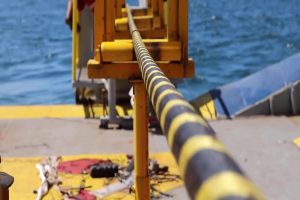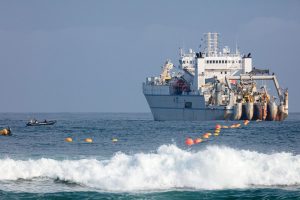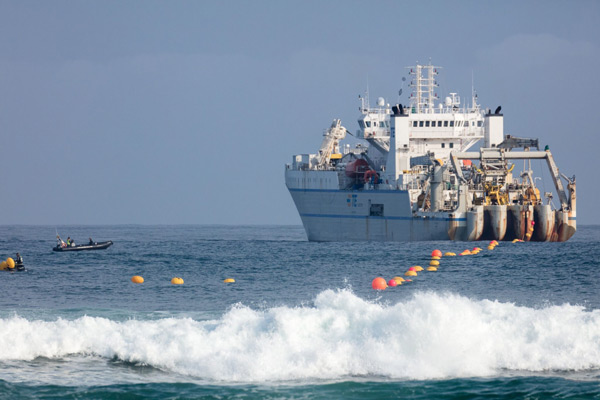Submarine cables are mainly divided into two types: communication transmission and power transmission.
The world’s first submarine cable was laid between England and France in 1850, and it took more than thirty years before other countries began to master the technology of laying them.
Power cables are commonly used to transmit electricity between land and islands, while communication cables carry the global Internet. Shallow sea cables are usually marked with warning signs or charts to warn ships to stay away.
And the huge financial and legal risks associated with damaging the cables usually keep ships away.
Deep-sea cables are arranged in the sea at depths of several thousand meters and are unlikely to be damaged by submarines and fishing vessels.
Combining these two reasons, the possibility of submarine cables being vandalized under normal circumstances is minimal.
Why do we need to build submarine cables?
After three industrial revolutions, mankind entered the information age, and submarine fiber optic cables have become the main artery for interconnections between countries around the world.
To date, more than 95% of the world’s international information transmission is carried by submarine fiber optic cables.
If one day, the global submarine cable fails at the same time, the finances will come to a halt, and international trade into recession, excluding satellite communications transmitted by the part of the information, many big events only months later we will know.

Currently, there are more than 300 transoceanic submarine cables around the world.
With the change of time, submarine cables have completed the qualitative change from copper core to fiber optic, and the volume of data transmission is rapidly climbing. The cable invested by Facebook to connect many countries in East Asia has even reached a superb data transmission capacity of 55Tb per second.
Google invested in a faster submarine cable, but also raised it to 60Tb per second.
Satellite Communication instead of Submarine Fiber Optic Cable
Some people think about replacing submarine fiber optic cable with satellite communication to see if it can somehow reduce the risk of submarine communication being destroyed by enemy countries during wartime.
Someone has long considered this issue and has been trying.
Only the RF bandwidth used by communication satellites can not support the Tb-level data transmission needs. In the future, for a long time, satellite communications can only be used as a supplement to submarine fiber optic cable communications.
Fishing Submarine Damage to the Cable
At the beginning of the design of the submarine cable, researchers have long considered that the fiber optic cable will face multiple threats such as high pressure of seawater, high salt corrosion, etc., so as much as seven layers of protection on top.
From the outside to the inside the polyethylene layer, polyester resin or asphalt layer, steel strand layer, aluminum waterproof layer, polycarbonate layer, copper or aluminum tube, paraffin alkane layer, and fiber optic layer.
It is well known that the great cohesiveness of steel is from the high salt content of its seawater.
With the outer polymer layer of the submarine fiber optic cable, the reaction between the reinforced steel cable and the salt water can be isolated to some extent.
Even if the outer layer is broken, there will still be layers of copper and paraffin to protect the fiber from damage.
The difficulty of ships and submarines to destroy deep sea cables has a lot to do with the length of the ship’s anchor chain and the way the submarine is moored.
In the deep sea, even if the ship throws all the anchor chains, it is impossible to touch the fiber optic cable.
Submarines, let alone submarines, can usually only be moored at a certain depth in the sea or the surface.
If you insist on stopping at the bottom of the sea, there is no difference with sinking.
The submarine fiber optic cable is always at the bottom of the sea, so if the submarine does not sit at the bottom, there is no possibility of being destroyed.
Even if the submarine cable is destroyed, human beings have long figured out how to repair the submarine fiber optic cable.
Submarine Fiber Optic Cable Repair
When the submarine fiber optic cable is damaged, fiber optic cable repair personnel use the principle of time domain reflection to send and receive a set of signals.
The time between when the signal is sent and when it is reflected is used to locate the exact location of the fiber breakage.
This is the signal reflection due to the internal breakage of the fiber.
The location of the break is determined and then a fiber optic cable repair vessel is sent to repair it, or in the case of water depths above 2000 meters, a robot is sent. The ends of the damaged fiber optic cable location are towed back to the ship for repair.
If it is more than 2000 meters, a deep-water grapple is used to hook the fiber optic cable back to the surface from the bottom of the sea.
If the seawater is too deep, the deep-water grapple can only be a heart, but not enough.
In this case, the cable will be cut off, one end will be fixed with a buoy, and then the other end will be dragged up with the grab.
In the middle of the welding spare cable, the entire cable is welded and tested successfully before being placed on the sea floor.
So far, the submarine fiber optic cable repair work was completed.

The Laying of Submarine Fiber Optic Cable
Fiber Optic Cable into the Sea Starting Point
At the fiber optic cable landing station, there is a shaft connected to the sea.
It is also equivalent to where the fiber optic cable begins its journey to cross the ocean.
Submarine Cable Trenching
In the shallow waters, the fiber optic cable is pulled to shore by small barges tied to floats.
The floats are then cut off to allow the cable to sink, and it is time for the subsea remote trencher to make its debut.
Under the powerful water jets of the machine, the shallow sea sediment was blown out of the trench nearly 3 meters deep.
Fiber optic cable laid on the sea floor with the help of self-weight, and then borrowed seawater tide will automatically fill the sand trench.
Line Testing
After the trench excavation, shallow sea cable laying is completed.
Into the deep sea, first by the fiber optic cable laying ship’s underwater detection instruments and remote-controlled robots to detect the seafloor. Bypassing the complex topography of the seafloor and numerous rock accumulation areas.
Aggregate into an accurate route survey guide map, and you can take the next step to put the excavator.
In a way, the safety of the submarine fiber optic cable, from its destruction after the unbearable huge economic compensation and severe criminal responsibility for the departure of deterrence.
Therefore, see the submarine fiber optic cable warning, the farther away the better, and work together to maintain the safety of the submarine cable.
